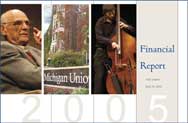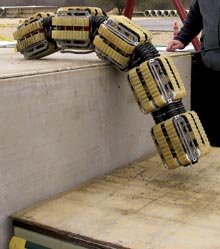

The University of Michigan is one of the largest research institutions in the world. Research expenditures reached $778 million in FY 2005. Below, a sampling of the thousands of research projects in progress this year:
A robot that walks like a human? The machine, known as RABBIT, was developed by U-M and French scientists over six years. It’s the first known robot to walk and balance like a human.
U-M researcher Jessy Grizzle, who helped develop the robot, said that the balancing ability programmed into RABBIT has many applications in the medical field, including so-called “smart” prosthetics that adapt to the wearer, and physical rehabilitation aids to help people regain the ability to walk.
 A new type of fiber-reinforced bendable concrete was ready for use for the first time in Michigan in 2005—and U-M scientists hope their new material will find widespread use. The concrete looks like regular concrete, but is 500 times more resistant to cracking and 40 percent lighter in weight.
The U-M technology has been used already on projects in Japan, Korea, Switzerland, and Australia.
A new type of fiber-reinforced bendable concrete was ready for use for the first time in Michigan in 2005—and U-M scientists hope their new material will find widespread use. The concrete looks like regular concrete, but is 500 times more resistant to cracking and 40 percent lighter in weight.
The U-M technology has been used already on projects in Japan, Korea, Switzerland, and Australia.
U-M team members were vital participants in the recent Huygens mission to Saturn’s moon, Titan. U-M Atmospheric, Oceanic, and Space Sciences Professor Sushil Atreya and Emeritus Professor George Carignan—together with colleagues from Goddard Space Flight Center and the University of Hawaii—couldn’t be happier with the performance of the 700-pound “suicide” probe.
“The Huygens probe has discovered a new world,” Atreya said. “And there is so much more to learn.”
A key to the success of the Huygens mission was the hardiness of the Gas Chromatograph Mass Spectro-meter (GCMS), an instrument built in part by engineers at the U-M Space Physics Research Laboratory.
 U-M paleontologist Philip D. Gingerich and colleagues at the Egyptian Environmental Affairs Agency (EEAA) announced in April the successful excavation of an unusually complete and well-preserved skeleton of the 40 million-year-old fossil whale Basilosaurus isis.
U-M paleontologist Philip D. Gingerich and colleagues at the Egyptian Environmental Affairs Agency (EEAA) announced in April the successful excavation of an unusually complete and well-preserved skeleton of the 40 million-year-old fossil whale Basilosaurus isis.
The new skeleton is 65 feet long and was found in Wadi Hitan in the western Sahara of Egypt. The skeleton will be shipped to Michigan for preparation and preservation, and replicated in a casting material suitable for reconstruction. The original fossil bones and a complete cast will be returned to Egypt.
Scientists at U-M have developed the first micro-machined, life-sized, mechanical cochlea, the tiny organ responsible for converting acoustic vibrations into electrical signals for the brain to “read” and interpret as different sounds.
Everyone knows that parents shouldn’t give young teens too much freedom. But a new study published in the March issue of Developmental Psychology shows that giving teens too little freedom can also put them at risk.
“Parents of young teens have to maintain a delicate balance in exercising control over their children’s social behavior,” said Pamela Davis-Kean, a psychologist with the U-M Institute for Social Research (ISR) and a co-author of the study with Sara Goldstein, now at the University of New Orleans, and U-M psychologist Jacquelynne Eccles.
This study confirms that young teens who spend a lot of free time in the absence of adult supervision are likely to get into trouble in school later on. But it also shows that problems are likely to develop when parents are intrusive and monitor teens too closely.
Materials scientists have long been fascinated by mother of pearl, also known as nacre, because of its strength. Now U-M researchers have succeeded in making artificial nacre.
“We think this material will be tremendously important because different sensors, different electronic materials, space shuttles, airplanes, and even cars require thin sheets of ultra-strong material,” said Nicholas Kotov, associate professor at the U-M College of Engineering.
 A virtually unstoppable “snakebot” developed by a U-M team resembles a high-tech slinky as it climbs pipes and stairs, rolls over rough terrain, and spans wide gaps to reach the other side.
A virtually unstoppable “snakebot” developed by a U-M team resembles a high-tech slinky as it climbs pipes and stairs, rolls over rough terrain, and spans wide gaps to reach the other side.
The 26-pound robot, called OmniTread, has a unique tread design which prevents it from stalling on rough ground, said research professor Johann Borenstein, head of the Mobile Robotics Lab at U-M. This makes it ideal for hazardous inspections or surveillance in industrial or military applications.
Older people are less likely than younger people to react aggressively when problems come up in their relationships, reports Kira Birditt, the Elizabeth Douvan Research Fellow at the U-M Institute for Social Research. “When they’re upset with others, older people are more likely to do nothing or to wait and see if things improve. Younger people…are more likely to argue and yell.
“These findings suggest that people may become better able to regulate their responses to problems as they age….They experience fewer interpersonal problems, feel less negative emotion, and use less destructive behaviors when upset with their social partners.”
In future research, Birditt hopes to explore how reactions to interpersonal stress influence psychological well-being. “People assume that it’s best to actively deal with interpersonal tensions by discussing problems and trying to figure out ways to solve them. But we found that most people avoid problems by not saying anything, ignoring the situation, and just letting it pass. Maybe avoidance isn’t such a bad way to deal with tensions after all.”
An international team of astronomers led by a U-M researcher has spotted the most distant massive object ever detected, a cluster of galaxies nine billion light years distant from Earth. “We now have a snapshot of the universe at a youthful age of less than five billion years, which is about one-third of the present age,” said project leader Christopher Mullis, a research fellow in the Department of Astronomy.
U-M researchers are developing methods to produce fuel cells at a fraction of the current cost by using microfabrication rather than traditional manufacturing processes. “We arrived at a system that works and uses steps very similar to those used to make microelectronic devices,” said Levi Thompson, U-M chemical engineering professor and leader of the research team working on the technology.
Microfabrication is the creation of physical structures whose component parts are sized around one micrometer. Microelectronics power a huge range of consumer goods, including hand-held computers. The high cost to build fuel cells is one of the biggest impediments to the commercialization of fuel cells, Thompson said.
Positive emotions like joy and humor help eliminate the race bias that may make people think members of other races “all look alike.” “Negative emotions like fear and anger create tunnel vision,” said U-M psychology researcher Kareem Johnson. “Positive emotions like joy and happiness are for long-term survival and promote big-picture thinking, and make you think in terms of ‘us’ instead of ‘them.’” The findings appeared in the journal Psychological Science.
The U-M College of Engineering has secured a $40 million Army research contract over five years to continue funding the Automotive Research Center (ARC). The amount is the largest research contract in the College’s history.
The funding is critical to advance research on both commercial and military ground vehicles, and to attract research on transportation energy, essential to both the military and Michigan’s auto industry.
The National Poverty Center received a third-year grant renewal of $1 million from the U.S. Department of Health and Human Services (HHS).
“This renewal of funds allows the National Poverty Center to continue to build on the activities of the past two years,” said Rebecca Blank of the Center and dean of the Gerald R. Ford School of Public Policy. The grants continue the long-term commitment by HHS to explore the causes and consequences of poverty and how to effectively alleviate it and its effects.